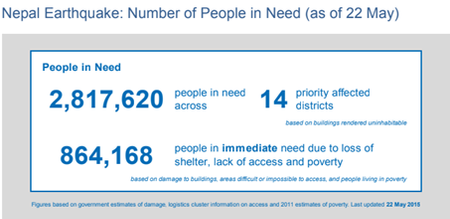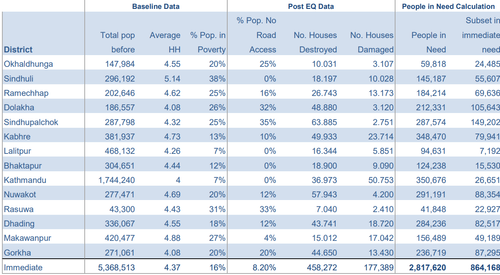...
The two main approaches to help identify PiN PIN are the top-down and the bottom-up approach.
...
Beyond the binary distinction between people in need/not in need, PIN estimates can be further refined or graded using intensity categories. This distinction is particularly used in contexts that are a) protracted and complex; b) experience regular and intense shocks with a very unequal distribution of impact on the population, and c) require prioritization of resources or geographical targeting. This is well established in some cluster practice, for example, the nutrition sector with clearly set thresholds reflecting different and mutually exclusive levels of malnutrition. Working with intensity levels calls for either developing complex composite measures, or using context adapted scales with clear definitions for each gradation, such as the Integrated Phase Classification (IPC) reference table for food security.
...
The limitations of this approach lies lie in the time required to create and agree on comparable intensity levels within and between sectors. In some instances, it might be easier to design only one cross-sector intensity scale (e.g., IPC), distinguishing between the population in moderate and acute need. Another limitation of the approach is the potential for bias when data is lacking.
...
When up-to-date, in-crisis information is not available, People in Need can be estimated based on location, pre-crisis vulnerability, crisis impact, and their status.
| Field Example: Nepal Humanitarian Crisis 2015 | |
|---|---|
The Assessment Unit in Nepal worked with the census, damage, vulnerability and access data to define the overall PIN. In their approach, they distinguished between people in need, defined as those who require assistance to be able to rebuild their lives, and people in immediate need due to “loss of shelter, lack of access to essential services and poverty”. The methodology used government statistics of fully and partially damaged houses (houses that cannot be repaired vs houses which are repairable) multiplied by the average household size, overlaid with poverty statistics and road access information. For areas without road accessibility, households with fully and partially damaged houses were all considered in need of immediate assistance, regardless of the poverty threshold, as they were expected to face significant logistical challenges to rebuild their houses during the monsoon. For areas where there was road access, fully and partially damaged households were considered in need of immediate assistance if they were below the poverty line in that district. The affected population was considered to have the most limited capacity to recover from earthquake losses due to their pre-existing financial circumstances and their location. People In Need =(Fully damaged households + Partially damaged households) X Average Household Size People in Immediate Need= PIN x ( Population in Poverty% + Population with no Road Access%) Limitations The limitations of this methodology include the assumption of a uniform impact of destruction on people above and below the poverty line. Poverty may be correlated both with lower impact- as low-rise housing less is likely to be destroyed or easier to rebuild- or higher impact, given a lack of resources to rebuild, repair or resupply. | |
The Assessment Unit in Nepal worked with the census, damage, vulnerability an access data to define the overall PIN.
They distinguished two distinct categories:
- People in Need- defined as those who require assistance to be able to rebuild their lives
- People in Immediate Need- people in immediate need due to loss of shelter, lack of access to essential services, and poverty
The response team used government statistics of fully and partially damaged houses (non-repairable v. repairable houses) multiplied by the average household size, overlaid with poverty statistics and road access information. For areas without road accessibility, households with fully and partially damaged houses were all considered in need of immediate assistance, regardless of the poverty threshold as they were expected to face significant logistical challenges to rebuild houses during monsoon season. For areas where there was road access, fully and partially damaged households were considered in need of immediate assistance if they were below the poverty line in that district. The affected population was considered to have the most limited capacity to recover from earthquake losses due to their pre-existing financial circumstances and their location.
People In Need =(Fully damaged households + Partially damaged households) X Average Household Size
People in Immediate Need= PIN x ( Population in Poverty% + Population with no Road Access%)Bottom-Up Approach
The bottom-up approach is used where estimates of population in need are already available but an overall PIN figure still needs to be agreed upon. The bottom-up approach consists of several aggregation rules, which if followed, will eliminate overlap and produce a best estimate of the overall, inter-sectoral number of People in Need.
...


